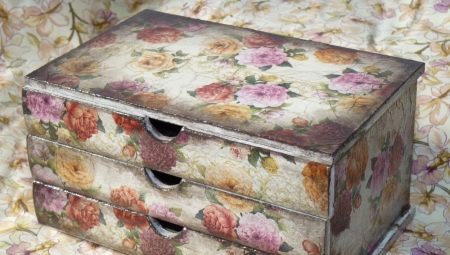If you feel the need for creative implementation, want to learn how to create unique and spectacular things with your own hands, you should try to master the decoupage technique. With its help you can do things of incredible beauty, while special special skills are not required. Mastering decoupage is quite simple, the main thing is to have a very strong desire.

What it is?
Decoupage - this is a certain technique of decoration, decor, which includes the ability to fix an image or pattern to any thing. The word itself comes from the French “cut out”. Pictures for decoupage, as a rule, are cut out, the whole composition is necessarily varnished.
The history of this technique dates back to the Middle Ages, when the Germans began to decorate furniture in this way. However, decoupage bloomed much later, in the 18th century, along with Asian-style decor. Furniture masters from Italy and France imitated very expensive inlays with glued pictures, which were carefully varnished from above.
Despite the fact that it was just an imitation, such furniture was in great demand due to the attractive price. In England, decoupage craftsmanship gained particular popularity in the era of Queen Victoria, it became available to most segments of the population.
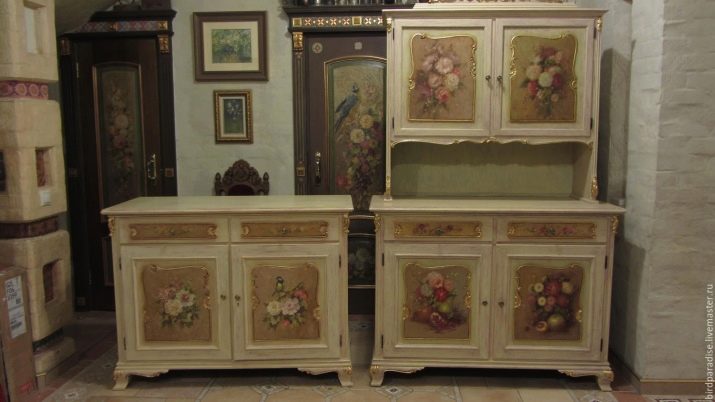
Already in the 19th century, decoupage needlework acquired the character of a mass in Europe - only styles changed, the technique was improved. At the turn of the century, decoupage fell on the American continent and became widespread there as a hobby.
In the modern world, decoupage art has gained a new round of development, thanks to new technologies, convenient tools and the return of fashion to the styles of Provence, Shabby chic and others. In our country, there is now a real boom in this type of decor.
In addition to traditional decoupling, a variety of techniques are used to create truly luxurious and unique creations: aging, gilding, voluminous and artistic decoupage.
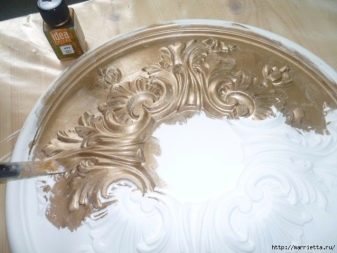

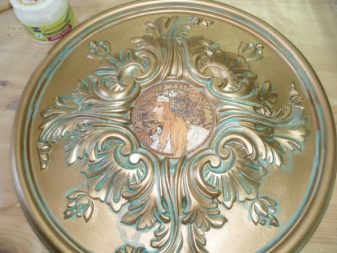
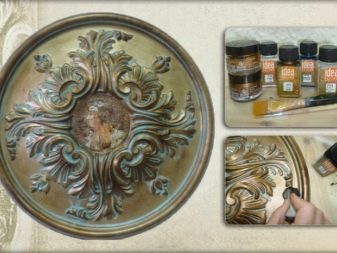
Views and styles
First of all, the main varieties of technology should be highlighted.
- Straight. Decoupage direct type consists in gluing the image on the surface of a thing from the outside. It can be painted, aged with craquelure or primed.
- Back. It can only be used to decorate transparent things, such as glass plates. Technically, direct and reverse decoupage are no different. The only caveat - the pattern is glued with the front side to the back of the subject. After that, the background, coating and other details are already drawn up.
- Art. It is also called smoky, it visually coincides with the painting, as these two techniques are perfectly combined with each other.
- Dekopatch. This is a continuous gluing method when the free surface of an object does not remain. Not only individual plots of images are used, but also a large number of fragments of patterns, which, like rags, are laid out on the surface of a decorated item.
- Volume. In this method, details of the surface being formed are visually performed in a three-dimensional form, rising above the rest of the composition. This selection is achieved by gluing a multilayer type, using special masses and pastes.
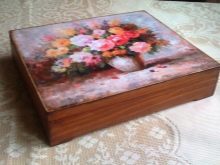
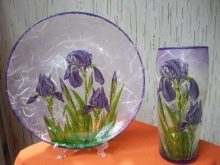
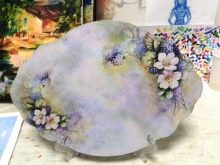
As for the styles, there are a number of basic ones, which, firstly, are popular on their own, and secondly, look appropriate in decoupage technique.
- Provence. This delicate rustic style of provincial France has not lost its popularity for many decades. He looks very restrained and softly, while expressively, deeply. Provence has many noble notes, grace, sophistication. Characteristic features are aged surfaces, scuffs, bumps, bleached wood, light shades, plenty of pastel. The calm color scheme perfectly resonates with floral motifs, floral ornaments, the image of small houses, lavender fields, grapes. The main colors: lavender, mint, rose, lemon, heavenly, white, beige, milk.
- Shabby chic. It is often confused with Provence, but for all their similarities, there are significant distinguishing features. In this style, a shabby surface, artificial aging, delicate colors, and floral designs are also welcomed. Blurry motifs, pink color, plots with angels, bouquets of roses, birds, magnificent castles prevail. This style has a lot of coziness and elegance.
- Simple City. This style is distinguished by the mood of unusual urban life, it is very democratic, it has many new and fresh ideas. The motives of newspaper and magazine subjects, torn edges prevail. Very concise style, appropriate in modern interiors.
- Victorian. Aristocratic and status, combining classic features with luxurious elements. In this style, gilding is often used, catchy expressive tones of greenery, red. Actively used strip, cell. As for the plot images, these are mostly animals, roses, oaks, still lifes, fox hunting. The background is predominantly dark wood or metal.

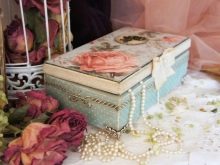

What tools and materials are needed?
Most often, those who begin to master the technique turn to the decor of some household utensils, so the foundation itself is already there. It can be cans and bottles made of glass, boxes of plastic, tin, metal. Specialists, however, recommend turning to other surfaces for starters. Glass and plastic things are quite difficult to decouple for a beginner, since they have a very weak coupling.
For starters, it's best to turn to plywood, wood surfaces of a flat type. It can be special blanks, panels, watches, caskets, cutting boards.

After you have decided on the basis, check what tools you need to purchase in order to start.
- Synthetic brushes. You will need a set of brushes of such a plan: a pair of flat, one round, several very thin brushes for painting. Focus on the fact that the brushes for varnish, soil, glue, paint should be different.
- Palette knife or spatula. You will need it when you want to hide a chip or add voluminous paste to the composition. If these tools are not at hand, you can use any plastic card.
- Sandpaper. It will allow to sand imperfections in the work, make the surface more accurate, destroy roughness. Select two leaflets with a fine and coarse grain on the basis of fabric.
- Foam sponges. This item can not be purchased specifically, but just take a sponge for washing dishes or a sponge for applying makeup.
- Palette. If you do not want to buy it in a special store, take an ordinary plate made of plastic or cardboard. True, after eating it will have to be thrown away.
Glass plates can also be used by fitting old unnecessary dishes that can be washed for these purposes.
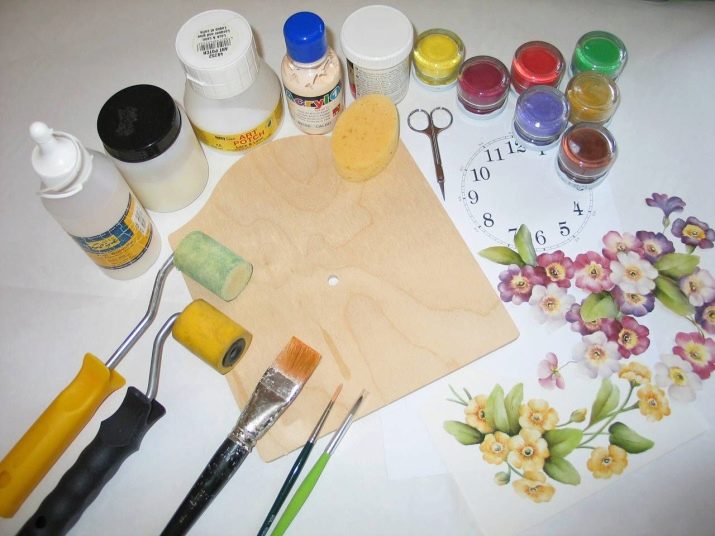
Additional tools that will greatly facilitate your work, although it is not required:
- dishes in which you will wash and store brushes;
- wet wipes;
- file for storing paper materials;
- sharp scissors.
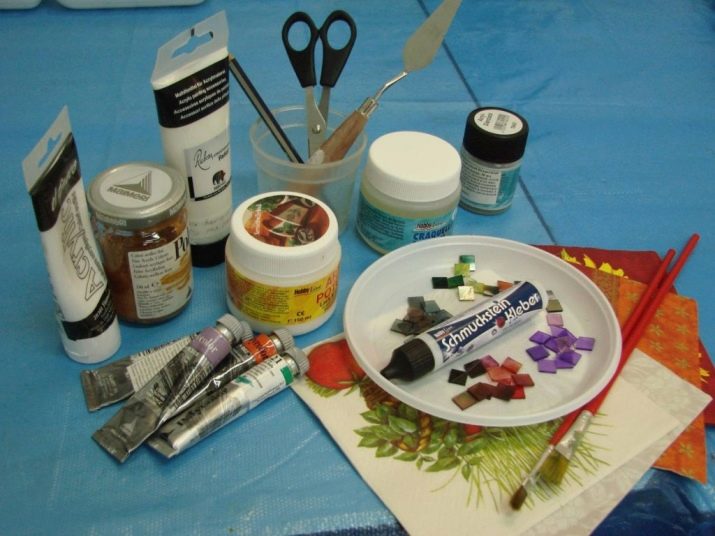
As for the materials, much depends on your imagination here, but the necessary set must still be acquired.
- Paper motives. It can be ordinary or special napkins, decoupage cards, rice paper, clippings and prints. To begin with, it is better to buy special materials that do not require the skill to work with them.
- Acrylic based primer. It’s impossible to do without this material, since it is the soil that provides high-quality adhesion to the surface, makes the image durable, resistant, levels the surface with which it is much easier to work with. Soil perfectly replaces white paint.
- Acrylic paint. To start, just a few jars or tubes with the shades you need are enough. Try not to buy too large volumes of paint, if you do not plan to constantly engage in decoupage. Black and white tone will be required. Among the popular ones are red, brown, ocher, blue, yellow. First of all, start from your main motive, choose tones in accordance with the image. If you decide to seriously engage in creativity, get a set.
- Water based acrylic varnish. Products decorated using decoupage technique are carefully varnished many times. If water-based varnish, it dries well. It is important not only the quality of the varnish, but also its properties of the external type. It can be of varying degrees of gloss, matte, semi-gloss. Here you need to proceed from the tasks that you set for yourself. In general, the necessary set consists of matte and glossy varnishes.
- Decoupage glue. Without it, it will not be possible to fix the image on the surface. You can choose the usual PVA, but there is a chance that it will eventually acquire a yellowish tone or crumble. Masters recommend buying a special decoupage glue or varnish-glue, which also allows varnishing.
- Contour from acrylic. Not mandatory, but very useful material, which allows you to effectively complete the composition, to surround the motive. Contours can be of different colors - golden, silver, white, black.
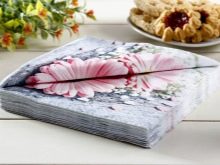
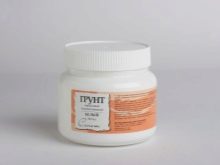

Beginners can try their hand at decoupage with the purchase of special kits that already have all the necessary materials to create this or that product.
How to do it right?
Decoupage technology often scares beginners, as there is a lot of information on it. In fact, it is enough to master a master class with your own hands once from beginning to end in order to understand it. Of course, you will have to go to the ideal result for some time, but a good result will be waiting for you already when manufacturing the first product. Experts recommend adhering to the following rules when mastering decoupage equipment.
- Color. Be sure to paint on the entire surface of the object that will be visible - if it is a flower pot, then the bottom of the outside and the upper part of the container to the ground should also be covered with paint.
- Choose light colors for the background. The main motives look more expressive on them. White dye or any light shade of pastel looks good, which is easy to obtain by combining the desired tone with white. In order to apply the dye, use a flat brush made of synthetics. Do this carefully so that the paint does not leak. After this procedure, always rinse the brushes.
- Let the base dry well. Do not proceed to the next steps earlier than half an hour. If in a hurry, blow dry the product with a hot air dryer.
- Paint again. If you notice imperfections after drying, color the item a second time and dry it.
- Only after that proceed to the formation of a plot plot.by cutting it out of napkins or other materials. Start with small pictures that are easier to stick without defects. If you use ordinary napkins, remove the lower layers, leaving only the upper.
- Try on the picture. Before you start gluing, be sure to check how the fragment will look in your chosen area.
- Apply glue with a flat brush. Move from the center to the edges, then place the pattern and glue it, smoothing wrinkles and folds - ideally, they should not be.
- Do not forget about varnish. After the glue has dried, varnish the product.
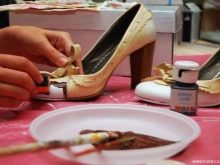
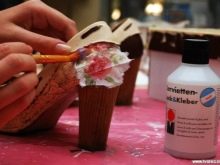
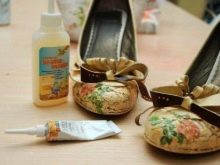
There are features of decoupage on the background of dark tones. To make the composition look harmonious, try to pick out motifs that organically combine with the background. On a dark basis, a drawing on a napkin can simply fade into the background, get lost. White background perfectly emphasizes the beauty of the picture, giving it expressiveness and brightness.
However, thick paper that is specifically designed for decoupage can also be used on dark substrates. Napkins can be used here as additional elements placed around the main one.
You can do this this way:
- paint the product with white paint;
- attach a napkin;
- dry everything;
- apply a matte type varnish;
- Without affecting the picture, paint the background with a dark shade, using a sponge for large areas and a thin brush to draw inside the picture.
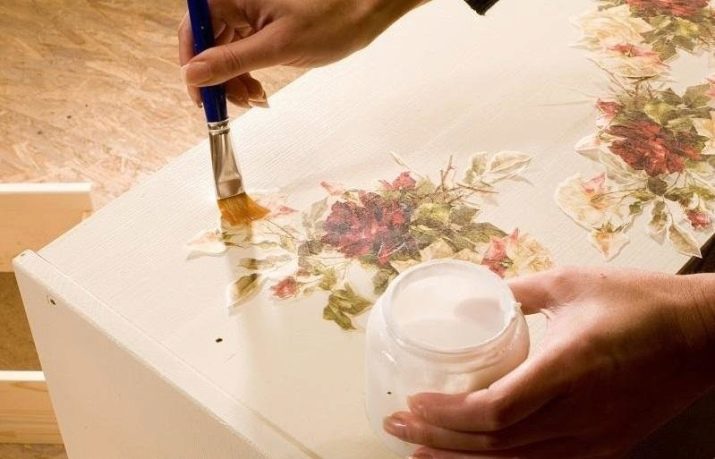
Second method:
- paint the background dark;
- paint part white where the napkins will be placed;
- place the pictures and fix them.
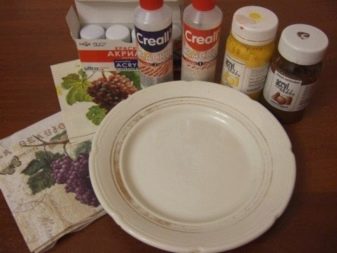
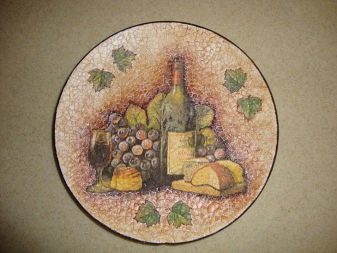
Do not be afraid of a dark background if you use expressive elements in the main motive:
- with silver;
- gold
- copper;
- bronze;
- large elements, faces, inscriptions, figures.

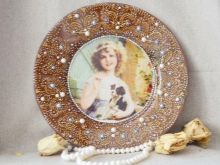
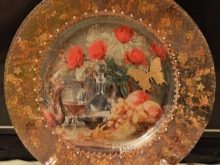
Decoupage masters have come up with a few rules that you need to know so that not only the result, but also the process will please you:
- the thicker the paint, the worse it lays down, dilute;
- several thin layers are more optimal than one very thick one;
- the thicker and thicker you smear, the more cracks will appear;
- the slower you dry the product, the longer it will retain its beautiful appearance;
- undershot worse than overdrying;
- do not spoil the decoupage with varnish;
- not happy with the result - fix everything with an emery cloth.

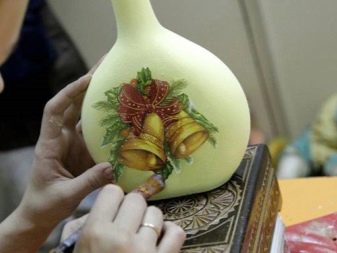
After you have studied all these tips and rules, you can begin to analyze the master classes.
Turn-based workshops
In fact, you can use decoupage in the design of absolutely any surfaces and objects - from bills to furniture and the refrigerator. As we already said, it is better to start with wooden substrates, gradually moving to glass, metal and plastic.

On wood
Wooden things are great for decoupling, as the surface is highly adhesive, provides good adhesion. You can try decorating a bird feeder, any wooden box: a box for spices, a chest, a bread box, a casket.
Very often, photo frames, paintings, banknotes are decorated using decoupage technique, form compositions on a tree cut. Where you start is up to you to decide.
We suggest you to master a step-by-step algorithm of actions when decoupage a wooden casket. Choose a rectangular box and follow the instructions.
- Prepare the surface. If the box is already framed and varnished, all this coating must be removed using coarse, and then soft sandpaper.
- Apply primer. Prime the entire surface with white acrylic or aqueous primer, varnish.
- Pick up the drawings. Then cut them out, try on the future product, and carefully think over the whole composition.
- Stick on. Saturate the image with glue and fix it on the box.
- Decorate. As soon as the glue dries, dip a brush in the paint of the desired pattern and create an effective contour, draw details. You can use gilding, silver, other contours.
- Do not forget about the finish. You will need two or more layers of varnish, which must dry completely before you begin to apply a new one. The surface should be perfectly smooth.
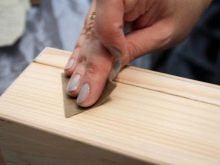
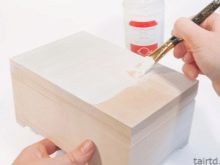
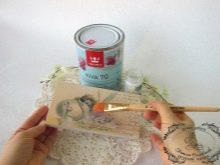
Board decoration with the help of a photo:
- select photos, scan them and print on thin paper, in no case use photo paper;
- cut out what you need;
- prepare the surface, if necessary, sand the old coating;
- ground the board in tone, contrasting photos: if the photo is bright, select a dark background, if dark - light;
- after drying, apply glue and place the picture;
- add decor or painting if necessary;
- varnish 2-3 times.

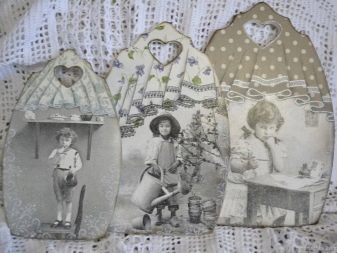
On top of the lacquered decoupage, you can create a craquelure coating if you want to visually age the product. To do this, you need to treat the surface with two compounds. To create the effect of a patina, that is, a cracked product, do the following:
- take a soft brush of high quality and apply a layer of the first craquelure composition;
- dry, but not completely, touch the surface - it should be slightly sticky;
- apply the second composition, dry as it should;
- then you need pigment type powder, shade or pastel, which you need to rub into a dried surface;
- rinse, dry, varnish.
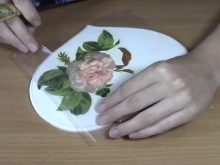
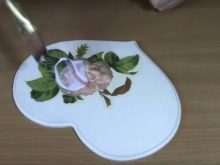
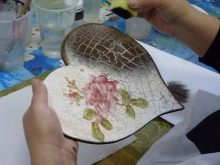
On glass
After you learn decoupage on wood, you can start decorating glass products: dishes, vases, glasses, mugs.
Decoupage mugs
For this you will need:
- the base, that is, the transparent glass mug itself;
- napkins with the chosen motive;
- acrylic paints to match the composition, always white;
- scissors;
- fan brush;
- paint brush;
- PVA glue;
- two containers;
- glossy varnish;
- sponge, trash bag.
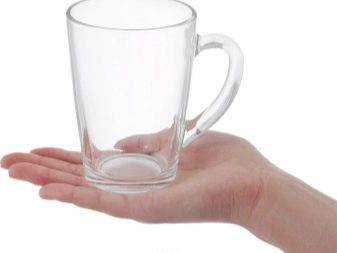
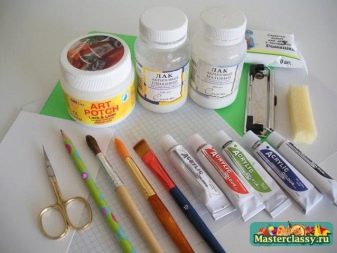
Step-by-step algorithm:
- pour white paint into one of the containers and paint the base with a sponge, excluding the bottom and the handle;
- we leave the product to dry for an hour and a half, after drying completely, paint again;
- dry again longer, can be left overnight;
- paint over the third time, carefully painting over all defects;
- completely dry;
- we cut the napkin in half, separate the top layer and apply it to the mug;
- in the second container dilute 1 to 1 glue and water, mix the composition;
- with a brush from the center to the edges glue the image first on one side, then on the other;
- dry the product;
- varnish, not less than 5 times, more is possible;
- after drying, apply the decor with gold or other paint.
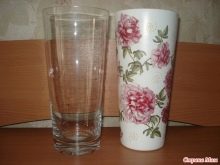

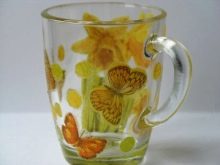
For metal
Decoupage on a metal surface can be done with tin boxes, a table lamp, a candlestick. We propose to decorate a metal garden watering can.
You will need:
- watering can;
- priming;
- napkins;
- acrylic based paints;
- single-phase craquelure;
- varnish;
- skins, sponges, brushes.
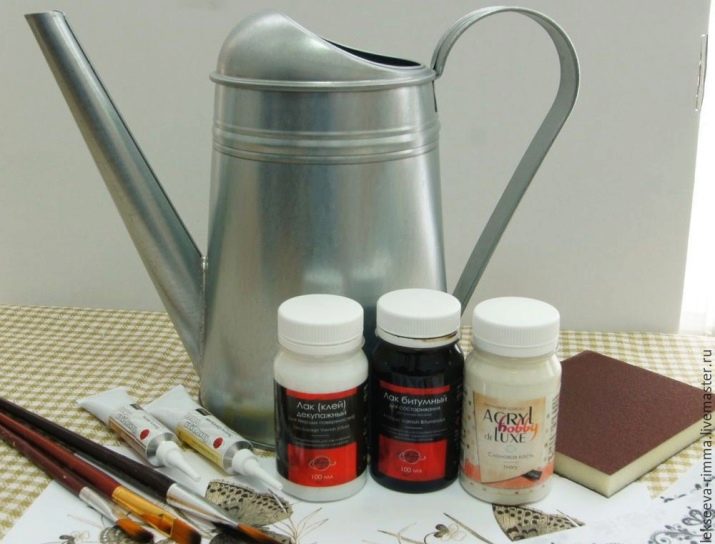
Step-by-step algorithm:
- sand the surface;
- degrease the surface with alcohol;
- primer;
- walk with a sponge on the surface, smoothing the marks of the brush;
- let the product dry properly;
- next, apply paint to those areas where there will be a craquelure coating, but not to the entire watering can;
- apply craquelure composition;
- you can apply the paint after it dries;
- wipe with a wet cloth the areas where you want to create scuffs;
- after drying, smooth the transitions from aging to cracked areas by painting with a sponge;
- paint over the remaining surface with white paint;
- dry well;
- select the fragments of napkins, cards or rice paper that you will use, and cut;
- if the background of the picture is white, then do not have to finish;
- glue fragments, laying them out on a file, place them in selected areas;
- go through the drawings with a roller, remove the file;
- varnish the product.


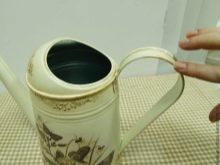
For plastic
Plastic products also look great in decoupage design. We offer you to decorate a plastic napkin holder. This is a simple process that will not take you much time.
You will need:
- blank - napkin holder;
- sandpaper;
- napkins;
- PVA glue, diluted 1 to 1 with water, or varnish;
- decor, paints and topcoat.
Algorithm of actions:
- prime the workpieces;
- after drying, sand the surface;
- Prepare a suitable size motif and cut it out;
- if the fragments are round, use the “file” method, which is given above;
- glue the pattern, moving from the middle to the edges;
- sand defects;
- then varnish the product;
- add the necessary decor, painting.
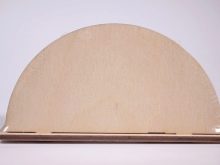
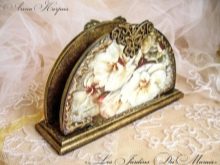
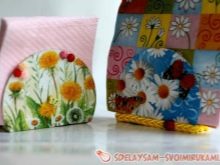
Interesting ideas
We bring to your attention beautiful ideas for inspiration. You can independently create a luxurious gift for your loved ones on March 8 using decoupage technique using a variety of techniques, decoration elements:
- black-and-white decoupage looks very impressive;
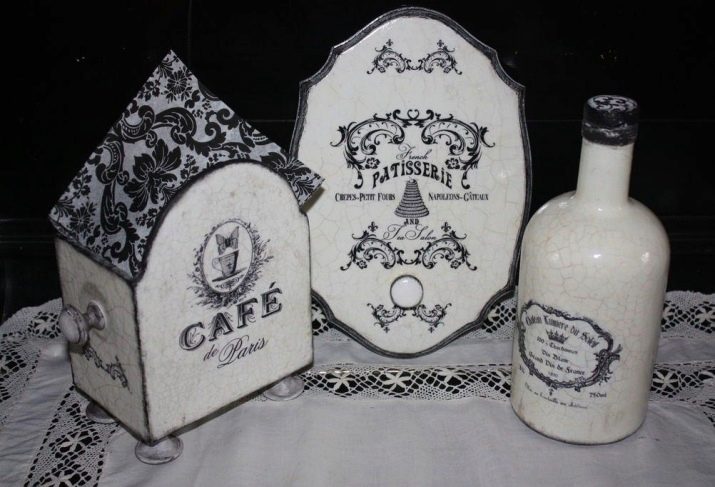
- egg shell decoration gives the impression of volume;

- decoupage crafts - a great gift for any holiday;
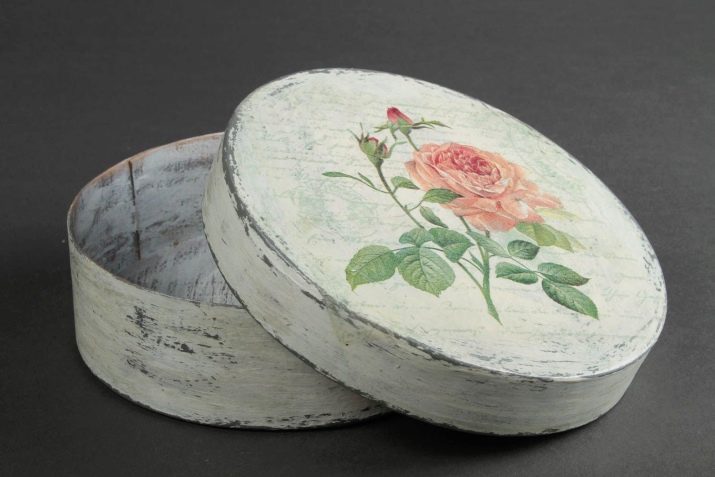
- wallpaper decorating is a great way to turn old furniture into a unique and elegant thing;
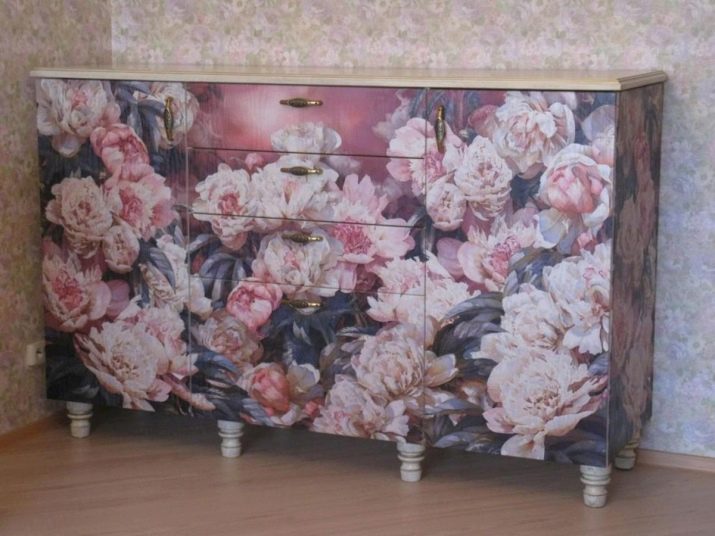
- imitation of stone gives the decoupage product special beauty and style;

- fabric and lace trim combine perfectly with this technique;
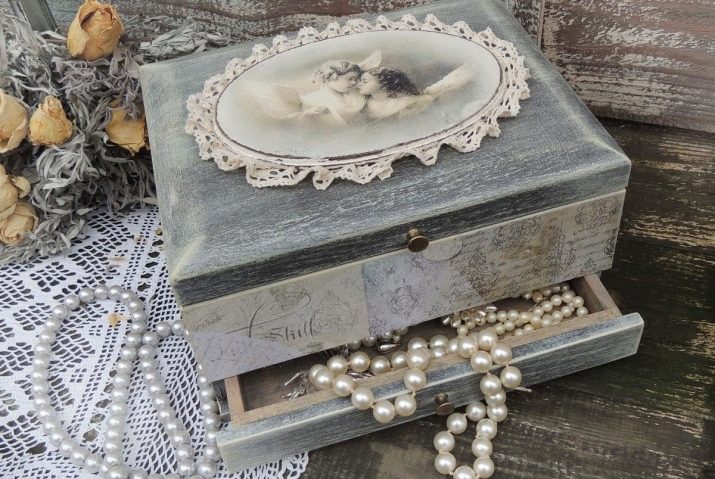
- decorated watering can;
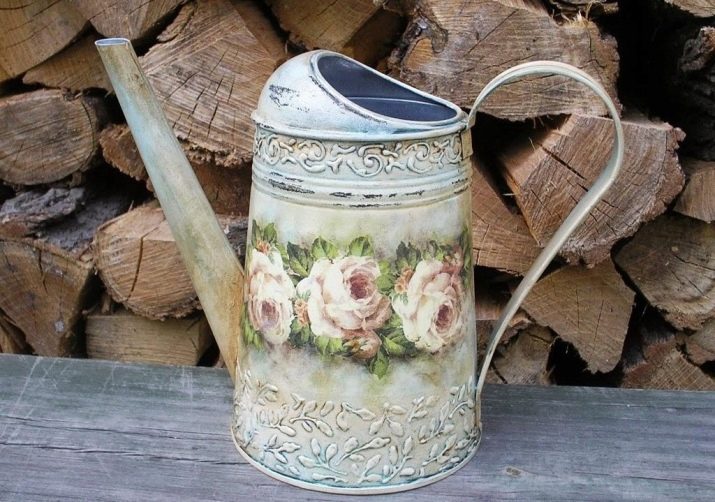
- a beautiful box is a wonderful present.
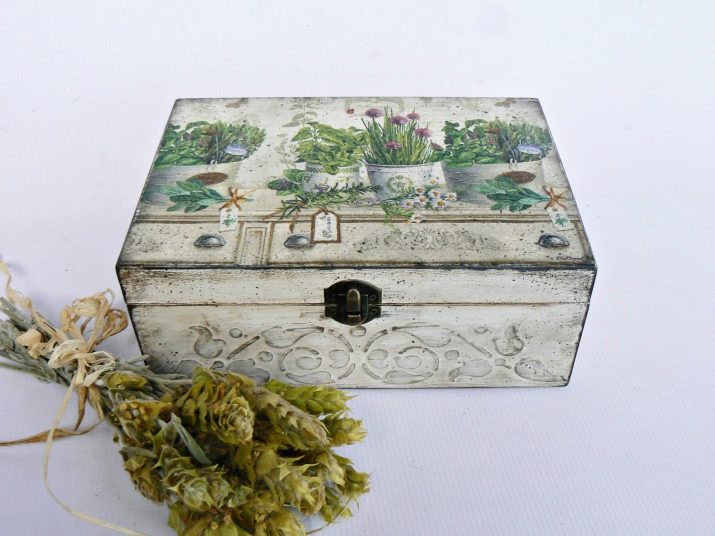
About what is needed for decoupage, see the video below.
